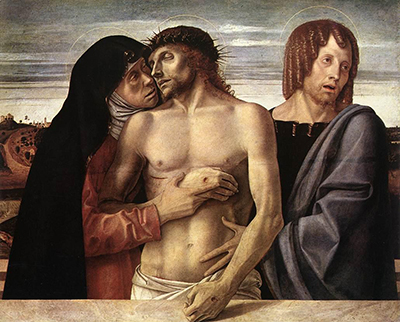This is a great painting done by Giovanni this is shown by how he painted it with both religious and psychological feeling.
The painting is thought to be done in the year 1470 when Giovanni Bellini was trying to use his own skills. The Virgin Mary is looking at her dead son with sorrowful eyes as depicted in the painting this is not always seen in Giovanni arts is an influence from Donatello's art in Saint Antony of Padua in Basilica. She is so close to the son that she places her chin on the his shoulder. She is holding the hand across the chest this part was probably inspired from a known Roman mosaic-icon in Gerusalemme Basilica.
The painting shows how tight she wants to hold her son and wishing to breathe life to him. With a keen look on the right hand there is a wound that was used to nail Him during crucifixion. On the other side Saint John the Evangelist is also seen to be in pain as from the face. He could not face Christ mother holding her lifeless son in pain he turned to the other side in anguish. The gestures seen in the painting may have been influenced by supporters of Francesco Squarcione, it looks more of Carlo Crivelli work that it was almost thought it was their art.
The artist tried to fix the three in a horizontal foreground. He painted the sky dull in grey- bluish colour that shows a cold mood accompanied with pain. This painting of the dead Christ supported by the Virgin Mary and St John the Evangelist is in a Tempera panel medium of about 34 × 42 inches. He used different materials like supports that hold the oil paintings.
Brush and knives were used to blend colours in the portrait. The skills used in this painting show a very emotional moment as he is using deep paintings incorporated with his artistic style. When he was painting this art he was tried to be independent and creative not to be influenced by his brother in-law Andrea Mantegna.
The art was once given as a present to Italy in 1811 by Eugene de Beauharnails when it had come from Bologna through Sampieri collection. Its commission is not known but is to date it is kept in Pinacoteca di Brera in Milan.




